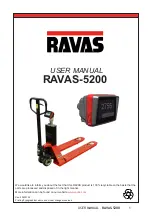
.
OPERATION
TROUBLESHOOTING
WHEN ENGINE RUNS
If the transmission and steering wheel can be operated, and the engine is running, it is possible to tow the
machine out of mud or to move it for a short distance to the edge of the road.
Check the effect of the brakes, and if the brakes do not work properly, take the action given in "When engine does
not run".
Check if it is possible to steer the machine. If the machine cannot be steered, follow the procedure given in
"WHEN ENGINE DOES NOT RUN".
The operator should sit on the machine being towed and operate the steering in the direction that the machine
is towed.
Always run the engine to allow the steering and brakes to be used.
WHEN ENGINE DOES NOT RUN
The brakes will not work, so be extremely careful.
Connect the towing machine securely to the towed machine. Use two towing machines of the same class or
larger than the machine being towed: connect one machine each to the front and rear of the machine being towed.
If it is necessary to change the direction of the machine being towed, it is possible to use the emergency steering,
but it can be used for a maximum of only 90 seconds.
If the emergency steering cannot be used, disconnect two hydraulic hoses each on the left and right from the
steering cylinders, then carry out the towing operation. When removing the hoses, block the hoses with plugs and
fit oil containers to the mouthpiece of the cylinder to prevent oil from draining to the ground.
3 - 106
Summary of Contents for HD785-5
Page 2: ... 1 1 ...
Page 4: ... FOREWORD FOREWORD 1 3 ...
Page 5: ... FOREWORD FOREWORD 1 4 ...
Page 15: ... 2 1 ...
Page 19: ... SAFETY SAFETY LABELS POSITION FOR ATTACHING SAFETY LABELS 2 5 ...
Page 47: ... 3 1 ...
Page 132: ... OPERATION OPERATION Brake performance Downhill distace Continuous Tire size 27 00R49 3 86 ...
Page 166: ... 4 1 ...
Page 237: ... 5 1 ...
Page 239: ... SPECIFICATIONS SPECIFICATIONS 5 3 ...
Page 240: ... 6 1 ...
Page 299: ... 7 1 ...




































